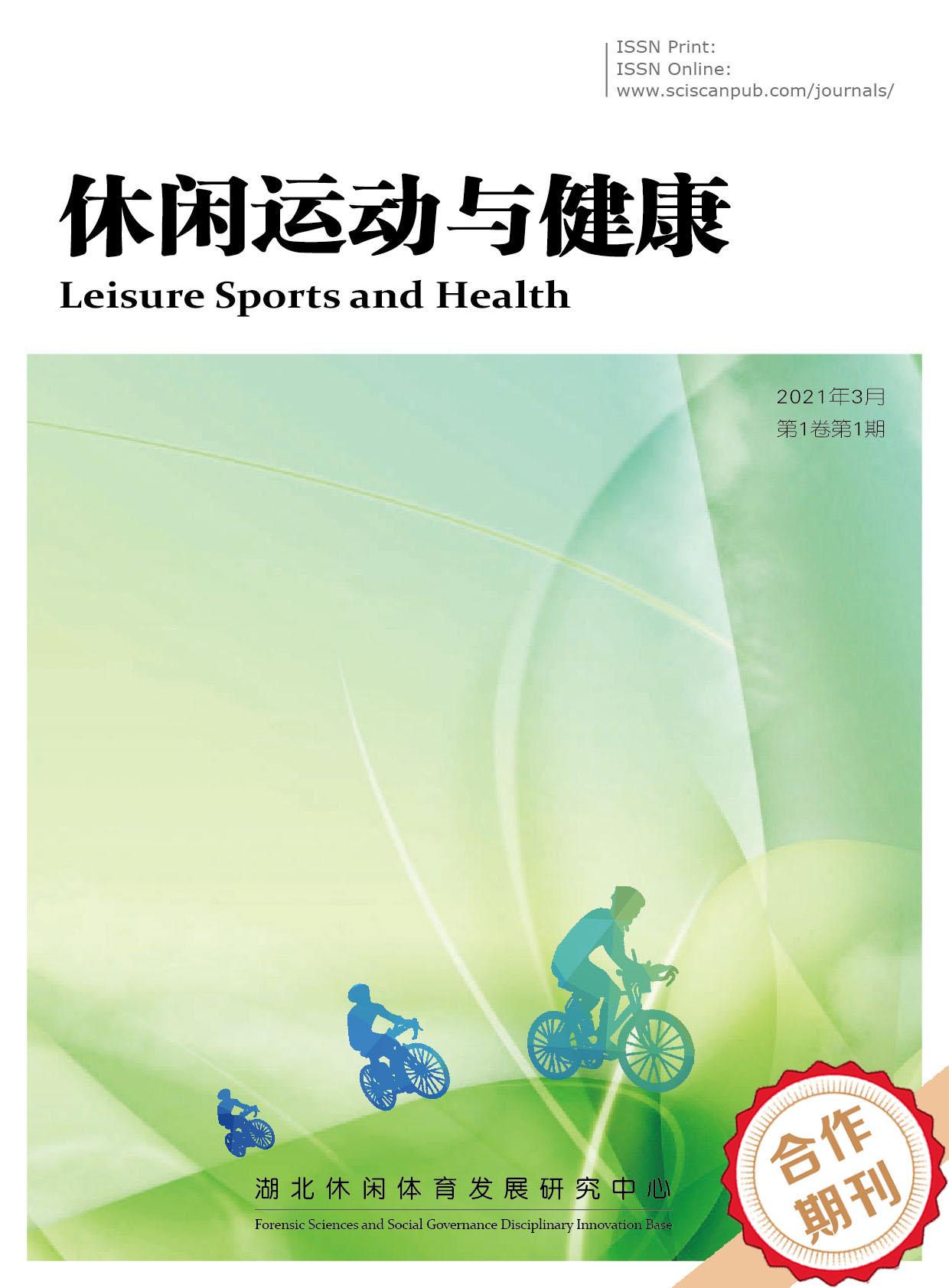Leisure Sports and Health
运动干预与健康教育对体质弱势群体小学生健康的影响
The Influence of Exercise Intervention and Health Education on the Health of Primary School Students in Physically Disadvantaged Groups
- Authors: 罗艳丽
-
Information:
湖北大学体育学院,武汉
-
Keywords:
Exercise prescription; Health education; Physically vulnerable groups; Primary school student运动处方; 健康教育; 体质弱势群体; 小学生
- Abstract: The purpose of this study was to explore the influence of different exercise intervention methods and health education on students’ physical and mental health, so as to help the disadvantaged primary school students choose scientific and reasonable physical exercise methods. Research methods: A total of 80 students from the fifth grade of Xiaogan Experimental Primary School were randomly selected to participate in this study according to the physical fitness test results. The experimental group received exercise intervention and health education for one semester, while the control group did not receive any intervention. Results: After exercise intervention and health education, the body shape of obese and thin primary school students in the experimental group gradually became normal; The Angle of pelvis forward is decreasing and the scoliosis is approaching the neutral position. The heart rate of the students decreased and their vital capacity increased significantly when they were quiet. After intervention, the 50 m running time of primary school students was shortened, the number of skipping rope per minute was increased, and the mean of sitting forward bend was increased significantly, showing significant differences compared with before intervention (p<0.05). In terms of mental health, there were significant differences between the experimental group and the control group in terms of subjective experience and physical value, with statistical significance (p<0.01). Conclusion: Exercise intervention and health education can improve the physical form, physical function, physical quality and mental health of primary school students in different vulnerable groups. 研究目的:探讨不同运动干预方式与健康教育对学生身心健康的影响,从而帮助体质弱势群体小学生选择科学合理的体育锻炼方式。研究方法:以孝感市实验小学五年级学生为对象,根据体质测试结果随机选择体质弱势群体共80人参与本研究,实验组进行一学期的运动干预与健康教育,对照组不进行任何干预。研究结果:在运动干预与健康教育后,实验组肥胖和瘦弱小学生的体型逐步趋于正常;骨盆前倾的角度在缩小、脊柱侧弯也在靠近中立位;学生安静时的心率有所降低、肺活量值较干预前有了极大提升;干预后小学生的50m跑时间缩短、一分钟跳绳个数增加、坐位体前屈的均值提高较明显,与干预前相比呈现出显著性差异(p<0.05);心理健康方面,实验组在主观体验、身体价值维度上的均值与对照组之间的差异非常显著,差异均有统计学意义(p<0.01)。研究结论:运动干预与健康教育对不同体质弱势群体小学生的身体形态、身体机能、身体素质及心理健康各方面都有所改善和提高。
- DOI: https://doi.org/10.35534/lsh.0302004
- Cite: 罗艳丽.运动干预与健康教育对体质弱势群体小学生健康的影响[J].休闲运动与健康,2023,3(2):18-25.
1 引言
随着时代的发展,越来越多的群体出现身体素质下降的现象,就连天生爱动的小学生,体育运动的能动性也出现下降趋势。学校和父母将大量精力和时间倾注在学生的学业成绩上,对课外体育锻炼不太重视,学生的课外休闲方式被互联网替代,完成学习任务后并没有投入身体活动中,使得部分学生出现肥胖或过于瘦弱现象;学生近视情况近年来也趋于低龄化,如今小学生戴上眼镜已不足为奇;由于学生生活习惯、行为方式和遗传因素的影响,使得部分学生出现脊柱侧弯、骨盆倾斜等现象。
鉴于此,为了针对性改善学生健康状况,提高体育教学活动效果,根据学生体质发展特点及运动能力,将其分为体质正常型和体质异常型两种。体质异常型是指不能够较好地完成现行课程标准所规定的教学任务,未达到预期教学目标的学生[1]。这部分学生中,有相当一部分属于体质弱势群体。所谓体质弱势群体,是指在身体健康方面处于不利地位,尤其是在从事以体力活动为主的,学习和生活方面处于不利地位的群体。其界定标准有两个,一是《国民体质测定标准》测试结果未达到及格,二是BMI测试结果达到或超过26.5[2]。在本文中主要指体质测试总成绩低于60分,身体形态表现为体型过度肥胖或瘦弱、脊柱侧弯或骨盆前倾的学生。本文以孝感市实验小学五年级学生作为研究对象,根据体质测试结果筛选出部分体质弱势群体小学生进行为期一学期的干预实验,探讨不同运动方式与健康教育对他们身心健康的影响,指导体质弱势群体学生科学合理地进行体育锻炼,来达到增强学生体质、增进身体健康,最终改善体质弱势小学生健康状况的目的。
2 研究方法
2.1 文献资料法
通过检索中国期刊全文数据库(CNKI)、万方数据库(Wanfang Data)、维普中文期刊全文数据库等中文数据库搜集数据和资源,以“运动处方”“运动干预”“健康教育”“体质弱势群体学生”检索,查阅与本课题相关的书籍、期刊文章,为本文研究奠定坚实的理论基础。
2.2 访谈法
实地走访了受试者及其父母、任课教师,了解并观察该群体平时的生活习惯、兴趣爱好、家庭和社区条件、平时的运动情况,为该群体小学生实施运动干预与健康教育提供参考依据。在征得学生家长同意和学生本人意愿后,签订知情同意书并设计实验方案。
2.3 实验法
1)实验思路
根据体质弱势群体小学生的身体健康状况,结合学校环境、家庭饮食习惯和个人兴趣爱好等特点,以处方的形式来确定体育课程内容,尽可能地丰富体育课的运动种类,明确有关的注意事项,避免出现损伤或伤病加重;对学生的身体状况进行调查时,加强和家长之间沟通交流,使家长了解基本运动知识;在运动处方实施的不同阶段,要及时进行运动处方的修订和运动效果的评定,根据学生的实际情况来制定出有针对性、明确目的性的运动疗法,保证运动处方安全有效的实施;在详实的资料收集和大量的数据测试的基础上,对肥胖和瘦弱、骨盆前倾和脊柱弯曲的小学生组织体育锻炼,保证运动处方干预能更安全、有效地达到训练效果;此外,通过健康教育知识普及,为其有效锻炼提供理论依据,使学生不仅仅身体素质方面得到改善,而且让学生明白健康的生活方式带来的益处,从而以最恰当的方式来增强体质,增进心理健康,促进学生更好的生长发育。
2)实验步骤
将筛选出的80名体质弱势群体分成实验组和对照组,实验组和对照组各为40人。实验组中,肥胖和瘦弱学生为20人、骨盆前倾和脊柱弯曲为20人,实施运动干预与健康教育;对照组不进行任何干预。在为期一学期的体育课教学后,对相同的体质弱势群体学生进行第二次身心健康的检测,实时记录数据。通过实验前后数据的对比,分析实验组和对照组体质弱势群体小学生指标数据在统计学有无差异性。
3)分组方式
(1)肥胖和瘦弱组:
体重指数:体质指数(BMI)=体重(公斤)/身高(米)的平方,我国学者研究认为:BMI<20 为偏瘦,20≤BMI<24 为正常,24≤BMI <26.5 为偏胖,26.5≤BMI为肥胖[3]。
肥胖儿童和瘦弱儿童与正常体重者相比,在身体素质方面表现出不同程度的降低。在心肺功能方面,肺活量指数与正常体重者不同、运动后心率恢复较慢;在身体素质方面表现为运动速度慢、爆发力不强、协调性和灵敏性不高、有氧耐力降低等。因此,要依据对测试分析的结论和教学环境的实际状况,以及该部分群体的具体情况,科学的制定处方,以求在短期内得到可观的教学效果。
(2)骨盆前倾和脊柱侧弯组:
脊柱侧弯是指在额状面上脊柱向左或向右偏离身体中线的弯曲,脊柱的侧弯一般会伴有脊柱的旋转[4]。轻度脊柱侧弯虽然不会直接威胁小学生生命,但也应引起重视,并抓住矫正脊柱侧弯的最佳时期[5]。骨盆的正常位置是在矢状面上,耻骨联合位于髂前上棘的前方,髂前上棘位于中心线上。骨盆前倾这一不良身体姿态,既会有损学生外在形象,又会对学生的站姿和行走姿势构成影响。通过查阅相关文献资料,根据实际问题来制定具有改善效果的动作,并根据学生出现的问题及时搜集学科前沿资料以及向专家咨询,保证练习动作的有效性和针对性。
4)教学方案
(1)体育课程运动方案:
①教师选择合理的教学内容:热身活动前的慢跑、有氧健身操来充当准备活动、课中设置游戏活动、课程结尾时结合音乐的放松操等,学校和教师应当加强体育管理,增大对运动器材的投入力度,课程中设置足球、排球、篮球、羽毛球等球类运动;健美操和广播体操等舞蹈动作;跳山羊、燕式平衡等体操动作;太极、五步拳等武术动作,尽可能丰富体育课堂的运动种类。
②课程安排及身体素质的锻炼方法:体育课中穿插身体素质的练习,在高强度的运动后,应安排强度较低的内容来调整,避免学生长期处于负荷较大的条件下,出现运动损伤。
③实时跟踪数据统计。
④比较运动干预前后相关指标的变化,进行数据分析,评定训练效果。
(2)健康教育方案:
健康教育不仅是通过肉眼可直接观察到的外在行为,而且还包括个体的内在情感、行为态度等内在行为。本次实验主要在实验组40名体质弱势群体学生中,随机抽取20人。采取集体授课的方法,进行为期一学期的健康教育,每周两次。通过对学生口头讲解、书本知识传授、开展讲座、观看视频、PPT及制作海报等方式实现健康教育,同时引导学生从身体健康和心理健康、社会因素来有意识地加强健康行为的形成。
2.4 测量法
身体健康的测量从身体形态、身体机能、身体素质三方面进行测量。身体形态用身高体重测量仪;脊柱侧弯采用“Cobb角”;骨盆前倾测量使学生呈站立位,上肢支撑,肩关节轻度屈曲 30 °。正常情况下,在矢状面上骨盆从髂后上嵴到耻骨支的正常前后角呈 30°,骨盆前倾—腰椎前凸或当 SS 大于45°时为骨盆前倾[6];身体机能用肺活量计和心率测量;身体素质用秒表、坐位体前屈测试仪、跳绳、仰卧起坐测试仪进行指标测量。
心理健康测量工具选取周成林2009年编制的青少年体育锻炼心理效益问卷,该问卷包括主观体验、身体价值、情绪活力、人际感知、困境应对五个维度[7]。为保证问卷的可靠性,利用“重测法”对问卷进行了信度检验。实验开始前,向80名体质弱势群体小学生发放测量量表,让其家长帮忙填写。在间隔两周后,再让这些家长填写同样内容的量表,以确保问卷的可信度,用SPSS26.0统计软件将收集的测量数据进行信度检验,得出r=0.86,信度较高。在实验前后正式向80名体质弱势群体小学生发放测量量表,实验前回收76份,有效问卷70份,回收率95%,有效率87.5%;实验后回收78份,有效问卷75份,回收率97.5%,有效率93.8%。
2.5 数理统计法
借助电脑SPSS26.0统计软件,将体质测试结果相关数据与信息进行统计、编号和录入,并对调查数据进行分类处理,最后用软件对所收集的数据采用t检验及描述统计方法进行统计分析,均值比较用X±S表示,显著性水平取p=0.05。
3 结果与分析
3.1 运动干预与健康教育对体质弱势群体小学生身体形态的影响
学生的身体形态可以根据肥胖和瘦弱、骨盆前倾和脊柱侧弯等测试指标来体现。首先,肥胖和瘦弱学生依据实验前后的身高、体重、体质指数的数据,探讨运动处方对该群体带来的影响;其次,脊柱侧弯和骨盆前倾学生通过观察脊柱和骨盆的形态,并在实验前后与正常身体姿态进行对比,分析是否有所改观。
1)运动干预与健康教育对肥胖和瘦弱小学生身高体重的影响
运动干预能有效提高肥胖学生自我意识水平,在一定程度上减轻或增加体重。因此,身体形态得到改善的同时,心理水平也在相应的提高,两者存在共变关系[8]。通过体育课传授基本运动知识,提升学生基本运动能力,掌握合理有效的运动训练方法,从而使身体形态随着年龄增长更加完善。干预前,对肥胖和瘦弱学生的身高、体重和体质指数进行了统计;干预后,对该群体学生进行了相同指标的测试,测试结果如表1:
表 1 肥胖和瘦弱学生体质健康相关指标干预前后的比较(x±s)
| 身体形态 | 指标 | 干预前 | 干预后 | ||
| 实验组 | 对照组 | 实验组 | 对照组 | ||
| 肥胖学生 | 身高 | 1.41±0.56 | 1.40±0.63 | 1.47±0.52* | 1.42±0.56 |
| 体重 | 48.4±5.1 | 48.6±8.3 | 40.3±4.2** | 46.1±6.5 | |
| 体质指数 | 24.3±16.2 | 24.7±20.9 | 18.6±15.5* | 22.9±20.7 | |
| 瘦弱学生 | 身高 | 1.39±0.54 | 1.38±0.51 | 1.46±0.47* | 1.41±0.53 |
| 体重 | 24.3±4.5 | 23.8±4.7 | 28.4±3.7 | 25.4±3.5 | |
| 体质指数 | 12.6±15.4 | 12.5±18.1 | 13.3±16.7 | 12.7±12.4 | |
注:“*”表示P<0.05;“**”表示P<0.01。
表1显示:经过一学期的运动干预与健康教育,实验组肥胖和瘦弱学生在身高指标上呈现出显著性差异(p<0.05),差异有统计学意义,表明运动干预对小学生身高有一定程度的影响。对照组学生身高也有所增加,表明此阶段的学生正处于生长发育的关键时期,身高呈现自然增长趋势;实验组肥胖学生体质指数干预前后变化较大,由干预前24.3±16.2减少到干预后18.6±15.5,呈现出显著性差异(p<0.05),且差异具有统计学意义。表明针对肥胖学生制定的运动处方,在体重、体质指数方面均产生了积极影响。实验组瘦弱学生体重和体质指数增加幅度较小,可能是由于运动干预时间比较短,使瘦弱学生的干预效果不明显。从体重来看,虽然实验组和对照组肥胖学生体重都有所降低,但是变化差异程度上来说,实验组肥胖学生体重降低程度大于对照组,实验组前后差异非常显著(p<0.01)。
2)运动干预与健康教育对脊柱侧弯和骨盆前倾小学生的影响
脊柱侧弯的测定指标通常为“Cobb”角,测量方法从上位终椎椎体上缘、下位终椎椎体下缘各划一直线所形成的交角即为Cobb角,角度越大、侧弯越严重[9]。在运动干预后通过肉眼从后面观看学生的脊柱形状,发现学生由运动干预前后背左右不平,逐渐改善成为一条直线且左右两侧对称。骨盆前倾的测量方法:上让学生双脚并拢,上肢支撑,肩关节轻度屈曲 30°。正常情况下,在矢状面上,骨盆从髂后上嵴到耻骨支的正常前后角呈 30°,SS的正常值范围30°~45°,当SS大于45°时,为骨盆前倾。脊柱侧弯和骨盆前倾学生体质健康相关指标干预前后的比较如表2。
表 2 实验组学生脊柱侧弯和骨盆前倾相关指标干预前后的比较
| 干预前 | 干预后 | |
| 骨盆前倾 | 骨盆位置向前倾斜了一定的角度,表现为小腹前凸、臀部后翘。腰和墙壁之间的距离约为一拳,SS>45° | 骨盆位置逐渐恢复正常,腰和墙壁之间的距离小于一拳,骨盆趋于中立位,SS值在45°左右 |
| 脊柱侧弯 | 脊柱某一段偏离身体中线,脊柱向侧方凸出弧形或S形。其中,大部分学生有轻度脊柱侧弯现象(Cobb角<25°),少部分学生有中度脊柱侧弯(Cobb角在25°~40°) | 脊柱在最佳矫正位进行锻炼后,畸形得到改善,脊柱侧弯形态得到改善。其中,大部分学生由干预前的轻度脊柱侧弯逐渐趋于正常,中度脊柱侧弯学生的角度在缩小 |
结果表明,运动干预后,学生在力量练习中提升了脊柱凸侧肌肉的收缩能力,拉伸练习提升凹侧肌肉伸展性,从而使脊柱两侧肌肉得到均衡发展,最终矫正脊柱形态。在运动处方的实施过程中,合理调整训练量和训练时间,以避免各种训练方式间的相互干扰。由于力量训练比姿势训练效果较明显,因此可适当增加力量练习并长期坚持训练以求达到更好的教学效果。
经过一学期的运动训练干预,脊柱侧弯和骨盆前倾学生变化情况如表3。
表 3 脊柱侧弯和骨盆前倾学生干预前后的比较(人数/%)
| 干预前 | 干预后 | |||
| 实验组 | 对照组 | 实验组 | 对照组 | |
| 骨盆前倾 | 10(12.5%) | 10(12.5%) | 6(7.5%) | 11(13.8%) |
| 脊柱侧弯 轻度 | 5(6.3%) | 5(6.3%) | 2(2.5%) | 7(8.8%) |
| 中度 | 5(6.3%) | 5(6.3%) | 3(3.8%) | 6(7.5%) |
表3的数据结果表明,干预后,实验组效果均优于对照组:实验组骨盆前倾学生人数由干预前的10人,减少为干预后的6人。对照组骨盆前倾学生人数则增加1人;实验组中度脊柱侧弯由干预前5人,变为干预后3人,对照组轻度脊柱侧弯学生身体形态在向中度脊柱侧弯转变,即有2名学生轻度脊柱侧弯学生变为中度脊柱侧弯。从实验数据可以看出,实验组学生在坐姿、站姿、写字姿势等方面逐渐养成了保持正确身体姿态的意识。
实验组骨盆倾斜和脊柱侧弯的角度在缩小,但效果不是很显著。这与谷梦云的实验结果不相吻合[10]。可能是由于角度测量仪器不够精确,使得数据存在误差;另一方面可能是由于干预的持续时间较短,实验效果没有很明显。
3.2 运动干预与健康教育对体质弱势群体小学生身体机能的影响
身体机能主要通过心率、肺活量等指标来体现,运动干预与健康教育前后这些指标的测量数据有无变化及变化大小可直接反映实验的干预效应。对学生实验前后的心率和肺活量进行测量与统计,测试结果如表4。
表 4 体质弱势群体小学生身体机能指标干预前后的比较(x±s)
| 身体机能 | 干预前 | 干预后 | ||
| 实验组 | 对照组 | 实验组 | 对照组 | |
| 心率 | 75.9±9.01 | 76.3±8.07 | 71.2±8.43* | 75.4±7.92 |
| 肺活量 | 2537±517 | 2548±437 | 2752±452* | 2594±313 |
注:“*”表示P<0.05。
测试结果显示出,在为期一学期的运动干预与健康教育后,实验组体质弱势学生的身体机能各项指标有了一定程度的变化。实验组学生的心率由干预前的75.9±9.01减少到71.2±8.43;肺活量由干预前的2537±517提升到2752±452。两个指标的均值在干预前后呈现出显著性差异(p<0.05),差异具有统计学意义。干预前后,实验组与对照组相比,实验组学生的肺活量指标增长幅度大,有显著性差异(p<0.05)。说明运动干预结合健康教育能达到改善学生身体机能的目的,提高呼吸系统和心血管系统的功能,使呼吸频率降低、肺呼吸的机能和效率得到改善。
3.3 运动干预与健康教育对体质弱势群体小学生身体素质的影响
身体素质从力量、速度、耐力、柔韧等几个方面来体现,因此,在今后的教学和课外活动中,应当从各个角度着手,抓住学生身体素质发展的敏感期,科学设计运动干预的内容,提高运动干预的质量,来全方位、有针对性的提升学生的身体素质[11]。体质弱势群体小学生在实验前后身体素质指标的统计数据如表5。
表 5 体质弱势群体小学生身体素质指标干预前后的比较(x±s)
| 身体素质 | 干预前 | 干预后 | ||
| 实验组 | 对照组 | 实验组 | 对照组 | |
| 50米 | 11.83±1.21 | 11.85±1.17 | 10.34±0.98* | 11.54±1.10 |
| 一分钟跳绳 | 42.48±9.36 | 40.61±8.23 | 57.61±8.7* | 46.11±4.2 |
| 坐位体前屈 | 4.05±3.25 | 4.25±4.21 | 6.03±2.33** | 4.83±2.46 |
| 一分钟仰卧起坐 | 20.41±7.03 | 17.98±6.47 | 30.30±6.13* | 20.13±4.53 |
注:“*”表示P<0.05;“**”表示P<0.01。
表5统计结果显示:运动干预后的测试数据与干预前比较,运动对学生身体素质效果显著,即实验组学生运动能力测试数据相较于干预前有了明显的进步。
(1)在50m短跑测试中,运动干预后,实验组学生时间有所减少,由干预前11.83±1.21减少到干预后10.34±0.98,且实验组的学生成绩比对照组可观,表明运动干预对学生的速度素质有积极影响。
(2)计时器记录一分钟跳绳个数,总体平均个数由运动干预前的42.48±9.36个,提升到了运动干预后的57.61±8.7个,相比体质测试标准个数来看,学生实际情况与标准值之间的差距在逐渐缩小。对照组学生的成绩也有所提升,结果有显著性差异(p<0.05),但提升的效果没有实验组明显。
(3)根据坐位体前屈的测试数据比较分析,在各种形式的体育运动干预后,实验组与对照组相比,体质弱势群体小学生的柔韧素质均值较干预前有很大提升,差异非常显著(p<0.01),有统计学意义。实验组学生在干预前后也发生了较大变化,由干预前4.05±3.25增加到变化后6.03±2.33。说明在运动干预与健康教育的影响下,不仅实验组与对照组相比,学生的柔韧素质得到较大提升,而且实验组学生坐位体前屈成绩在实验前后也相应提高。
(4)记录学生一分钟仰卧起坐,来检测体质弱势群体学生的腰腹力量,从而判断在身体素质与腰腹力量之间的关系,通过实验数据发现,二者大致呈正比关系。实验组与对照组相比,实验组的干预效果更好;实验组测试数据由干预前的20.41±7.03提升到实验后的30.30±6.13,实验前后有显著性差异(p<0.05)。对照组学生未进行较为系统的锻炼,所以两次测试结果的差异不显著(p>0.05)。
3.4 运动干预与健康教育对体质弱势群体小学生心理健康的影响
体育锻炼能提高体质弱势群体学生的心理健康水平,在集体活动中发挥个体的潜能,提高自我效能感,从而缓解该群体在面对困难时的担忧和不确定感[12]。在实施健康教育与运动干预后,实验组体质弱势群体小学生心理健康水平总体上得到提高,表明运动干预的实用性和针对性较强[13]。滕国容历时6个月,对学生心理行为及个性特征进行干预,结果肥胖儿童体重减轻、心理行为和个性特征也得到改善[14]。因此本实验对体质弱势群体学生的心理健康进行干预,干预前后数据如表6。
表 6 体质弱势群体小学生心理健康各维度干预前后的比较(x±s)
| 心理健康 | 干预前 | 干预后 | ||||
| 实验组(n=40) | 对照组(n=40) | p值 | 实验组(n=40) | 对照组(n=40) | p值 | |
| 主观体验 | 23.21±5.01 | 23.06±6.03 | 0.916 | 25.43±4.03 | 23.24±6.22 | 0.004** |
| 身体价值 | 24.34±5.85 | 24.27±5.79 | 0.891 | 26.47±4.02 | 24.56±5.01 | 0.007** |
| 情绪活力 | 22.84±6.13 | 22.56±6.05 | 0.923 | 24.35±4.80 | 22.72±6.19 | 0.104 |
| 人际感知 | 23.01±6.71 | 22.63±6.75 | 0.756 | 24.05±5.47 | 22.94±6.69 | 0.218 |
| 困境应对 | 23.52±5.93 | 23.05±5.63 | 0.532 | 25.46±4.52 | 23.86±5.85 | 0.072 |
注:“*”表示P<0.05;“**”表示P<0.01。
表6显示:干预后,实验组与对照组相比,实验组体质弱势群体小学生在情绪活力、人际感知、困境应对三个方面的均值均高于对照组,说明健康教育干预方案对学生的心理健康能产生一定的效果,但差异不显著(p>0.05)。效果最为明显的是实验组与对照组在主观体验、身体价值维度这两方面呈现出显著性差异(p<0.05),差异具有统计学意义;实验组主观体验指标,由干预前23.21±5.01提升到干预后25.43±4.03、身体价值指标由干预前24.34±5.85增加到干预后26.47±4.02,表明健康教育可以提升人的主观感受,体验各种积极的情绪,正确认知身体的价值。总之,实验组体质弱势群体小学生不仅使情绪情感得到提升,而且在妥善管理自己情绪的同时,也能感知他人的情绪,建立良好的人际关系。另一方面,运动干预与健康教育还可以培养小学生顽强的意志品质、在出现极点时克服生理惰性继续坚持运动、建立良好的人际关系和乐观开朗的性格、提升适应外界环境的能力。
4 结论与建议
4.1 结论
(1)经过为期一学期的运动干预与健康教育,体质弱势群体小学生的身体形态发生了明显的变化,身体形态从肥胖和瘦弱、骨盆前倾和脊柱侧弯两方面来体现,具体体现如下:
肥胖和瘦弱学生身高体重指标,实验组肥胖和瘦弱学生在身高指标上呈现出显著性差异(p<0.05),实验组肥胖学生体质指数干预前后变化较大,由干预前24.3±16.2减少到干预后18.6±15.5,呈现出显著性差异(p<0.05),表明针对肥胖学生制定的运动处方,在体重、体质指数方面均产生了积极影响;实验组瘦弱学生体重和体质指数增加幅度较小,可能是由于瘦弱学生的体质情况与肥胖学生有差异,而且干预持续时间有限,短时间内对瘦弱学生的影响不明显。
脊柱侧弯和骨盆前倾测量数据,实验组骨盆前倾学生人数由干预前的10人,减少为干预后的6人。对照组骨盆前倾学生人数则增加1人;实验组中度脊柱侧弯由干预前5人,变为干预后3人,对照组轻度脊柱侧弯学生身体形态在向中度脊柱侧弯转变,即有2名学生轻度脊柱侧弯学生变为中度脊柱侧弯。
(2)实验前后指标测量数据有无变化及变化大小可直接反映实验的干预效应。实验后,体质弱势群体小学生的身体机能发生了明显的变化,身体机能主要通过心率、肺活量等指标来体现。具体体现为:实验组学生的心率由干预前的75.9±9.01减少到71.2±8.43;肺活量由干预前的2537±517提升到2752±452,两个指标的均值在干预前后呈现出显著性差异(p<0.05),差异具有统计学意义。干预前后,实验组与对照组相比,实验组学生的肺活量指标增长幅度大,有显著性差异(p<0.05)。
(3)身体素质从力量、速度、耐力、柔韧等几个方面来体现,具体从50 m短跑、一分钟跳绳、坐位体前屈、一分钟仰卧起坐四个方面反映学生的身体素质。实验结果表明,运动对学生身体素质效果显著,即实验组学生运动能力测试数据相较于干预前有了明显的进步。
50 m短跑测试,由干预前11.83±1.21减少到干预后10.34±0.98,且实验组的学生成绩好于对照组,表明运动干预对学生的速度素质有积极影响;一分钟跳绳实验组学生由干预前的42.48±9.36个,增加到57.61±8.7个,对照组学生的成绩有所提升,但提升的效果没有实验组明显;坐位体前屈的测试数据比较分析显示,实验组与对照组相比,体质弱势群体小学生的柔韧素质均值较干预前有很大提升,差异非常显著(p<0.01),实验组学生由实验前4.05±3.25增加到6.03±2.33;一分钟仰卧起坐实验数据显示,实验组的干预效果好于对照组;实验组测试数据由干预前的20.41±7.03提升到实验后的30.30±6.13。
(4)运动干预与健康教育对体质弱势群体小学生心理健康有积极影响,实验组体质弱势群体小学生心理健康水平总体上得到提升。结果表明,主观体验、身体价值两个维度具有显著性差异(p<0.05)。实验组主观体验指标,由干预前23.21±5.01提升到干预后25.43±4.03、身体价值指标由干预前24.34±5.85增加到干预后26.47±4.02,表明健康教育可以提升人的主观感受,体验各种积极的情绪;实验组体质弱势群体小学生在情绪活力、人际感知、困境应对三个方面好于对照组,但差异不显著。教师关注学生的心理健康教育,能有效解决体育教学过程中的问题,提升教学质量,使学生在掌握运动技能的同时,养成健全的认知。
4.2 建议
(1)“体质弱势群体”的出现具有社会发展的必然性,建议从学生个体出发,根据他们的体质健康状况提出针对性的运动干预策略,时常传授健康教育方面的知识,逐步引导弱势群体小学生树立良好的体育价值观念。不仅是在运动干预时要根据个体制定处方,而且心理健康教育中也要做到因材施教,结合体育教学来开展有针对性的心理健康教育,教师要对不同学生的情况有所把握[15]。
(2)就体质弱势群体小学生而言,除了引导他们加强体育运动,增强体质外,还应注重合理饮食,平衡膳食,使机体各方面得到更好的发展;同时,要教导他们改善不良的生活习惯,科学运动,以防脊柱弯曲和骨盆前倾。家长和老师应当起到督促作用,帮助身体形态不良的小学生尽快恢复到正常的体态。
(3)学校应加强对体育的重视程度,根据学校实际情况,有选择地将体质测试结果纳入期末考核中;教师不断摸索最适合学生的教学方法来提升小学生的运动兴趣,特别是鼓励体质弱势群体小学生积极地参与到体育锻炼中来。
(4)适时对小学生进行健康教育,以确保小学生及其家长的健康生活习惯有效养成,从而为小学生的健康成长作出保证。对教师来说,应具备良好的心理素质为学生树立榜样、开设创新型的课堂氛围、在心理健康中做到因材施教,调动弱势群体小学生的学习兴趣,帮助他们树立自信,提高自我认知水平。
(5)心理健康教育与体育教学之间的融合,是教师对学生成长情况的关注点。教师设计丰富的体育教学方案,指导学生体育教学过程中进行心态的调整,进而在对学生的积极情感进行培养的基础上,促进二者之间的融合。通过体育教学方案的有效丰富,教育学生调节自己在体育教学过程中的心态,帮助培养学生正确的情感,进而实现体育教学与心理健康教育的充分融合。
参考文献
[1] 刘明.体育教学中体质异常型学生的安全隐患与防护措施[J].体育教学,2011,31(3):46.
[2] 韩勤英,孟园园.3-6岁学龄前儿童体质弱势群体运动干预实验研究[J].福建体育科技,2021,40(4):69-73.
[3] 杨锡让.运动生理学学科现状与进展[J].北京体育大学学报,2004(9):1153-1158.
[4] Byrd 3rd J A,Scoles P V,Winter R B,et al.Adult idiopathic scoliosis treated by anterior and posterior spinal fusion[J].The Journal of Bone and Joint surgery,1987,69(6):843-850.
[5] 漆航.运动联合健康教育对轻度脊柱侧弯小学生的干预性研究[D].扬州:扬州大学,2019.
[6] TeffreyGrossM D,杨贵勇.肌骨骼检查法(第二版)[M].沈阳:辽宁科学技术出版社,2003.
[7] 周成林,刘微娜,赵洪朋,等.青少年体育锻炼心理效益评定量表上海市常模的制订[J].体育科学,2011,31(9):51-56.
[8] 袁凌燕,纪成强,沈建华.群体运动干预青春启动前期肥胖学生身体形态与自我意识的共变研究[J].西安体育学院学报,2017,34(3):348-353.
[9] 马晓.儿童不良身体姿态矫正的实验研究[D].北京:首都体育学院,2010.
[10] 谷梦云.矫正小学生骨盆倾斜运动干预方案的研制与应用[D].北京:北京体育大学,2019.
[11] 卢桂兵.运动干预对小学生体质健康水平影响研究[J].南京体育学院学报(自然科学版),2015,14(5):33-37.
[12] 郭文,曹蕾,陈志鹏.不同运动干预对体质健康突出问题大学生体质健康、运动愉悦感与规律运动的影响[J].武汉体育学院学报,2012,46(3):91-96.
[13] 余玲,夏君玫,张伟伟.运动干预对弱体质学生群体心理健康和自我效能感的影响[J].武汉体育学院学报,2013,47(8):73-76.
[14] 滕国容.家庭学校综合干预对单纯性肥胖儿童心理行为及个性特征的影响[J].当代护士(学术版),2010(6):31-33.
[15] 王翠.小学体育教学中渗透心理健康教育的方法研究[J].青少年体育,2020(1):56-57,90.
















